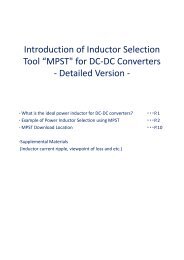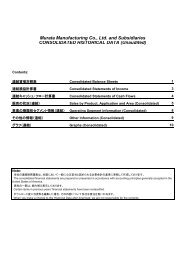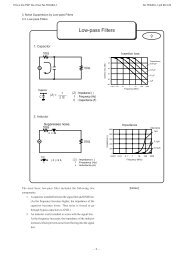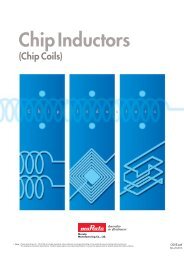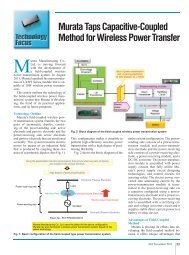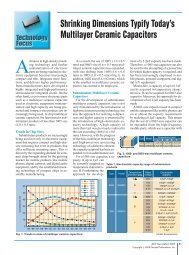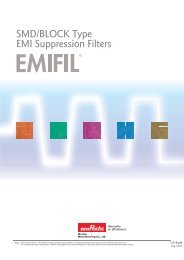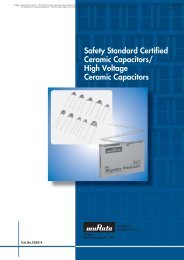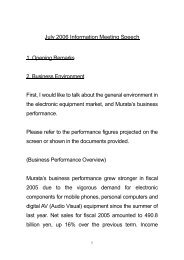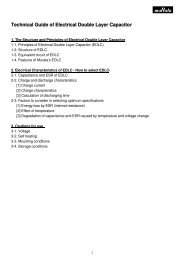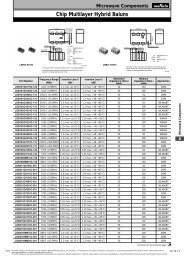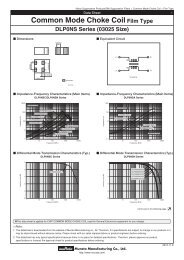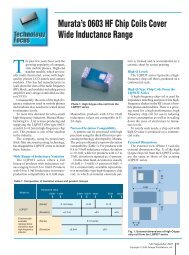PTC Thermistors POSISTOR ® for Circuit Protection - Murata
PTC Thermistors POSISTOR ® for Circuit Protection - Murata
PTC Thermistors POSISTOR ® for Circuit Protection - Murata
You also want an ePaper? Increase the reach of your titles
YUMPU automatically turns print PDFs into web optimized ePapers that Google loves.
!Note • Please read rating and !CAUTION (<strong>for</strong> storage, operating, rating, soldering, mounting and handling) in this catalog to prevent smoking and/or burning, etc.<br />
• This catalog has only typical specifications. There<strong>for</strong>e, please approve our product specifi cations or transact the approval sheet <strong>for</strong> product specifi cations be<strong>for</strong>e ordering.<br />
R90E.pdf<br />
Sep.24,2012<br />
!Caution/Notice<br />
c Notice (Soldering and Mounting) PRF18/21 Series<br />
1. Solder and Flux<br />
(1) Solder Paste<br />
(a) Flow Soldering: Use Sn:Pb=60:40wt%,<br />
Sn:Pb=63:37wt%, Sn:Ag:Cu=96.5:3.0:0.5wt% or<br />
equivalent type of solder.<br />
(b) Reflow Soldering: Use Sn:Pb=60:40wt%,<br />
Sn:Pb=63:37wt%, Sn:Ag:Cu=96.5:3.0:0.5wt% or<br />
equivalent type of solder paste.<br />
For your reference, we are using "63Sn/37Pb<br />
RMA9086 90-3-M18," manufactured by Alpha Metals<br />
Japan Ltd., "96.5Sn/3.0Ag/0.5Cu<br />
M705-GRN360-K2-V," manufactured by Senju Metal<br />
Industry Co., Ltd. <strong>for</strong> any internal tests of this product.<br />
(2) Flux<br />
Use rosin type flux in the soldering process.<br />
If the flux below is used, some problems might be<br />
caused in the product characteristics and reliability.<br />
Please do not use these types of flux.<br />
<br />
0.2wt%).<br />
<br />
(*Water-soluble flux can be defined as non-rosin type<br />
flux including wash-type flux and non-wash-type flux.)<br />
2. Cleaning Conditions and Drying<br />
To remove the flux after soldering, observe the following<br />
points in order to avoid deterioration of the characteristics<br />
or any change to the external electrodes' quality.<br />
(1) Cleaning Conditions<br />
Solvent Dipping Cleaning Ultrasonic Cleaning<br />
2-propanol<br />
Less than 5 minutes<br />
at room temp.<br />
or<br />
Less than 2 minutes<br />
at 40˚C max.<br />
Less than 1 minute<br />
20W/L Frequency<br />
of several 10kHz<br />
to 100kHz.<br />
A sufficient cleaning should be applied to remove flux completely.<br />
(2) Drying<br />
After cleaning, promptly dry this product.<br />
3. Soldering Conditions<br />
In your mounting process, observe the following points in<br />
order to avoid deterioration of the characteristics or<br />
destruction of this product. The mounting quality of this<br />
product may also be affected by the mounting conditions,<br />
shown in the points below.<br />
(1) Printing Conditions of Solder Paste<br />
(a) Recommended thickness of solder paste printing<br />
should be from 0.15 to 0.20mm.<br />
(b) After soldering, the solder fillet should be a height<br />
from 0.2 mm to the thickness of this product (see the<br />
figure at right).<br />
(c) Too much solder result in excessive mechanical<br />
stress on this product. Such stress may cause<br />
cracking or other mechanical damage. Also, it can<br />
destroy the electrical per<strong>for</strong>mance of this product.<br />
E<br />
Electrode<br />
Solder<br />
T<br />
Solder<br />
0.2mm V T V E<br />
Continued on the following page.<br />
94




